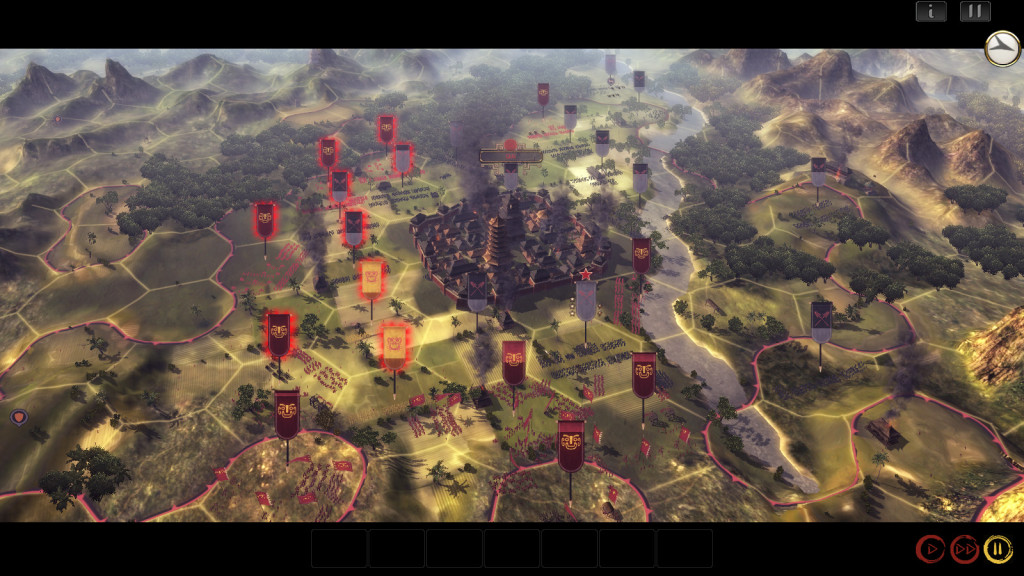- A spiritual successor to KOEI’s Romance of the Three Kingdoms?
- Oriental Empires Q&A, with Bob Smith
Oriental Empires is an upcoming 4X strategy game that will cover most of Chinese history, from 1500 BC to 1500 AD. My interest piqued, I conducted an email Q&A with developer Bob Smith. Read on:
About the developers
1. Hello, and welcome to the site! Please tell us a bit about yourselves.
Development of Oriental Empires is being led by R.T. Smith and John Carline, two veteran strategy game developers with more than 30 years’ experience between them. Previously they worked together on the Total War series of games, in roles including Project Director and Lead Artist, and have credits on many other AAA titles from studios including Crystal Dynamics, Pandemic, Frontier Developments, and Slightly Mad Studios.
2. Your best-known previous work was Total War. What lessons have you learned from your experience with those games?
That you can’t please everyone, that you’ll never ship the perfect product, and that the bigger your team, the more features you’ll have that don’t quite join up.
About Oriental Empires
3. At first glance, Oriental Empires looks like a cross between Civilization V, Endless Legend, and Romance of the Three Kingdoms XI. What are your influences and how have they shaped the game?
The initial inspiration was to create a civilization building game based on Eastern civilization, and having an interesting combat system. Superficially this is similar to Civ, but I don’t think the games feel alike to play. The battles obviously have some similarity to Total War games, but again, the resemblance is superficial as you don’t directly control them. History, reality, space 4X games, and miniature and board games are also influences.
4. Will battles take place on a separate tactical map (a la Total War and the older Romance of the Three Kingdoms games)? Or will all battles take place on the strategic map?
The battle system is probably the most innovative feature of the game. Players plot orders for their armies during their turn, then when they hit the End Turn button, the armies start to move, and if opposing forces meet, a battle occurs. All the battles take place in realtime right on the campaign map. If you want to, you can zoom in and watch your soldiers duking it out, or you can ignore battles that are boring or one sided. Players don’t directly control their units in battle, but can set formations and battle plans beforehand. Battles generally only last a minute or two, so the game moves along faster than games where you have to fight each battle on a separate tactical map, and you never have to choose between fighting a dull battle and taking your chances with the auto-resolve.
5. Oriental Empires will cover most of Chinese history, from 1500 BC to 1500 AD. What are some of the eras/conflicts you plan to spotlight? And to what extent will the gameplay reflect the evolution of Chinese technology, government, etc over this period?
Players start off at the dawn of recorded history controlling a single settlement in typical 4X style, so the way the game develops is up to the player, and won’t exactly match actual history. However, the game depicts the technological and cultural developments that occurred during the period with a particular emphasis on those that are uniquely Asian. If players chose the historical map, they will face the same shaping forces as their historical counterparts. So factions in the north will initially be stronger, having more easily available land, but will have to face dangerous nomadic factions from the steppe. Southern factions will develop more slowly as they have many forests and marshes to clear, but over time the balance of power will swing their way. Of course, if you play a random map, anything can happen.
6. Besides the setting, what other innovations do you plan to bring to the strategy genre?
The two largest features are the battles as mentioned above, and the ability to seamlessly zoom from a strategic overview, to a really close up view where you can see your peasants toiling in the fields, or watch your soldiers fighting in combat. The ability to step right into the game world in this way really adds a huge extra level of immersion that might not be apparent until you try it.
There are some other features that are interesting too. There are no recruitment queues for armies; instead a realistic model is used whereby you can muster as many men as you have available. The game also models two of the main driving conflicts of Chinese society, that between the peasants and the nobles, and that between the farmers and the nomads. So the unrest level of peasants and nobles is tracked separately, and decisions you make that will please one group may annoy the other. Similarly food production is handled differently for farmers, and nomads who depend on their animals, giving them different development dynamics.
Wrapping up
7. Do you have any final message for the readers?
May you live in interesting times, but not so interesting that you don’t have time to play games.
Thank you for your time.
Oriental Empires is due for an Early Access release in summer 2015.
Discover more from Matchsticks for my Eyes
Subscribe to get the latest posts sent to your email.




1 thought on “Oriental Empires Q&A, with Bob Smith”